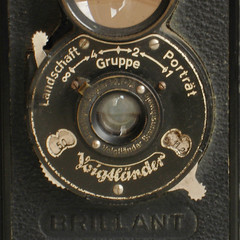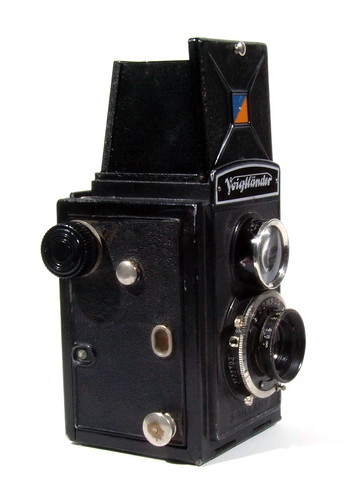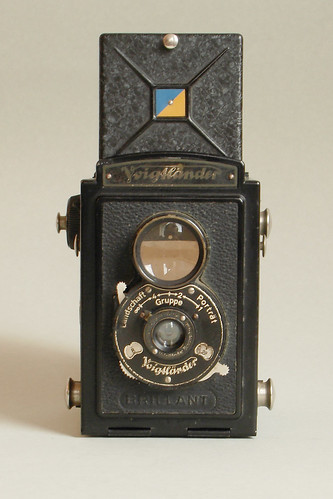Difference between revisions of "Brillant"
m (→Focusing and controls: f7.7 or f9) |
(expanded, added more info and photos) |
||
| Line 3: | Line 3: | ||
}} | }} | ||
| − | + | '''Voigtlander Brillant''' is a series of [[pseudo TLR]] and true [[TLR]] cameras taking 6x6cm exposures on roll [[120 film]], made by [[Voigtländer]] & Sohn AG, Braunschweig, Germany and produced between 1932-1951. | |
| − | |||
== Introduction == | == Introduction == | ||
| − | |||
The first [[Voigtländer]] '''Brillant''' was released in 1932. This early model resembles a [[TLR]] but it is functionally closer to a box camera, since it cannot be focused in the viewfinder. It uses 'zone-focusing' for which one has to estimate the distance to the subject. To assist this estimate, three situations are marked around the taking lens: ''Porträt'', ''Gruppe'' and ''Landschaft'' (i. e. ''Portrait'', ''Group'' and ''Landscape''). While TLRs of the same period have a rather dim ground-glass viewfinder, the Brillant has a so-called [[brilliant finder]] made of plain glass. | The first [[Voigtländer]] '''Brillant''' was released in 1932. This early model resembles a [[TLR]] but it is functionally closer to a box camera, since it cannot be focused in the viewfinder. It uses 'zone-focusing' for which one has to estimate the distance to the subject. To assist this estimate, three situations are marked around the taking lens: ''Porträt'', ''Gruppe'' and ''Landschaft'' (i. e. ''Portrait'', ''Group'' and ''Landscape''). While TLRs of the same period have a rather dim ground-glass viewfinder, the Brillant has a so-called [[brilliant finder]] made of plain glass. | ||
| − | The 1932 version has a metal body. From 1937 onwards, Brillants were made of [[bakelite]], a polymer, and introduced an accessory compartment for an extinction meter or filters | + | The 1932 version has a metal body. From 1937 onwards, Brillants were made of [[bakelite]], a polymer, and introduced an accessory compartment for an extinction meter or filters. |
The next major step took place in 1938, with the introdcution of the '''Focusing Brillant'''. A small opaque spot is added in the brilliant finder to focus on. The viewing and taking lens are coupled outside the body through gears. After the introduction of this focusing model, the zone-focusing models continued to be produced. | The next major step took place in 1938, with the introdcution of the '''Focusing Brillant'''. A small opaque spot is added in the brilliant finder to focus on. The viewing and taking lens are coupled outside the body through gears. After the introduction of this focusing model, the zone-focusing models continued to be produced. | ||
| Line 19: | Line 17: | ||
|image_source= http://www.flickr.com/photos/50678983@N00/402033478/in/pool-camerawiki | |image_source= http://www.flickr.com/photos/50678983@N00/402033478/in/pool-camerawiki | ||
|image= http://farm1.static.flickr.com/129/402033478_c3f070c9be_m.jpg | |image= http://farm1.static.flickr.com/129/402033478_c3f070c9be_m.jpg | ||
| − | |image_align= | + | |image_align= right |
|image_text=f9-lens model marked in German | |image_text=f9-lens model marked in German | ||
|image_by= Dries van den Elzen | |image_by= Dries van den Elzen | ||
| Line 25: | Line 23: | ||
}} | }} | ||
| − | Pre-1938 models use zone focusing. This means there are three markings: ''Portrait'', ''Group'' and ''Landscape'', each supposing a standard distance or depth-of-field. A small table with the right distances is provided in the manual (see links) or inside the accessory-shoe holder. Different language versions were made for various markets; German, English and Czechoslovakian<ref>The terminology used is common to both Czech and Slovak.</ref> versions have been reported. Apart from this zone-focusing, a distance scale in meters or feet and a [[depth-of-field]] scale are provided to let the photographer make an educated guess of whether the picture will be in focus. | + | Pre-1938 models use zone focusing. This means there are three markings: ''Portrait'', ''Group'' and ''Landscape'' (Porträt, Gruppe and Landschaft), each supposing a standard distance or depth-of-field. A small table with the right distances is provided in the manual (see links) or inside the accessory-shoe holder. Different language versions were made for various markets; German, English (their name became "Brilliant"), Spanish, French, Italian, Polish and Czechoslovakian<ref>The terminology used is common to both Czech and Slovak.</ref> versions have been reported. Apart from this zone-focusing, a distance scale in meters or feet and a [[depth-of-field]] scale are provided to let the photographer make an educated guess of whether the picture will be in focus. |
| + | |||
Three shutter speeds are provided; B, 1/25 and 1/50s. The aperture can be set at f9 or f7.7<ref>[http://www.flickr.com/photos/awcam/3224251756/ Photo of f7.7 model]</ref> (full aperture), 11 and 22. The latter two are made by rotating a punched disc with between the lenses. A better model with an f4.5 lens with a [[diaphragm]], and 8-speed [[Compur]] shutter was also available. | Three shutter speeds are provided; B, 1/25 and 1/50s. The aperture can be set at f9 or f7.7<ref>[http://www.flickr.com/photos/awcam/3224251756/ Photo of f7.7 model]</ref> (full aperture), 11 and 22. The latter two are made by rotating a punched disc with between the lenses. A better model with an f4.5 lens with a [[diaphragm]], and 8-speed [[Compur]] shutter was also available. | ||
| − | + | ||
| − | |||
| − | |||
| − | |||
| − | |||
| − | |||
| − | |||
| − | |||
The introduction of the '''Focusing Brillant''' added a third way of focusing: a visual focus check on a small dot of ground glass in the viewfinder. | The introduction of the '''Focusing Brillant''' added a third way of focusing: a visual focus check on a small dot of ground glass in the viewfinder. | ||
| − | |||
== Eva Besnyö == | == Eva Besnyö == | ||
Famed Hungarian-Dutch photographer Eva Besnyö used a Brillant for her early work. | Famed Hungarian-Dutch photographer Eva Besnyö used a Brillant for her early work. | ||
| + | == Variations == | ||
| + | The Brillant is a large range of pseudo-TLR cameras, (box-reflex), and later true TLR cameras. There are many lens and shutter combinations, varied from type to type and in time. | ||
| + | There are two body type: | ||
| + | |||
| + | '''Metal body cameras''' (1932-37) | ||
| + | *The serial number begins with a letter (D-1932 to J-1937) | ||
| + | *These early models resemble a TLR but it is functionally closer to a box camera, since it cannot be focused in the viewfinder | ||
| + | *There are two models: | ||
| + | **'''First metal model''' the front focusing ring has no distance scale, there are markings on the front panel as Portrait, Group and Landscape (Porträt, Gruppe and Landschaft) | ||
| + | **'''Second metal model''' has classic front focusing ring, w/ distance scale | ||
| + | '''Bakelite body cameras''' (1937-51) | ||
| + | *Have no serial numbers | ||
| + | *Introduced an accessory compartment for an extinction meter or filters. This 1937 version is known as the Brillant V6 | ||
| + | *Most models have a swing door for accessories; some have a rotating accessory door | ||
| + | *The Brillant S (1938), or Focusing Brillant, is the only one with a finder lens coupled with the taking lens. After the introduction of this focusing model, the zone-focusing models continued to be produced. | ||
| + | The Soviet camera factory [[GOMZ/LOMO]] made Komsomolets and [[Lubitel]] cameras that were clearly based on the Voigtländer Brillant Bakelite models, especially Brillant V6 | ||
| − | |||
| − | |||
| − | |||
| − | |||
| + | {{Flickr_image | ||
| + | |image_source= http://www.flickr.com/photos/s-demir/5828913416/in/pool-camerawiki | ||
| + | |image= http://farm4.static.flickr.com/3508/5828913416_c35c3858db.jpg | ||
| + | |image_align= center | ||
| + | |image_text= Voigtländer Brillant second metal model (c.1937) w/ Anastigmat Skopar 75mm f/4.5, and Compur (F.Deckel) central leaf shutter, speeds: 1-1/300 +B & T | ||
| + | |image_by=Süleyman Demir | ||
| + | |image_rights= with permission | ||
| + | }} | ||
| + | ===Specifications of metal models=== | ||
| + | *Taking Lens: various lenses | ||
| + | *Focusing: manual front focusing, guess the distance; Focus range: 1-8m +inf | ||
| + | *Shutter: various central leaf shutters, speeds: 1-1/300 +B & T; do not cock the shutter for B & T, diaphragm opens by pressing the shutter release | ||
| + | *Cocking lever: on the lens-shutter barrel | ||
| + | *Shutter release: on the lens-shutter barrel | ||
| + | *Cable release socket: on the lens-shutter barrel | ||
| + | *Frame counter: a red window on the right side of the camera, advance type, manual reset by a small button on the right side of the camera, after loading the film push the button to the right, number 1 appears in the window. | ||
| + | *Viewfinder: waist level non focusing finder, really brilliant, plain glass, hood opens by a knob on top of it, there is an exposure index on the back side of the hood | ||
| + | *Winding knob: on the right upper side of the camera, no double exposure prevention | ||
| + | *Back cover: Hinged, opens with the hinged bottom plate together via a latch on the bottom plate; Red window: on the bottom plate | ||
| + | *Film loading: fit the roll film the place under the bottom plate, take-up spool under the back cover | ||
| + | *Others: Tripod socket 3/8 inch; Strap knobs; Body metal; Weight: 569g | ||
==Notes== | ==Notes== | ||
<references /> | <references /> | ||
Revision as of 09:21, 5 August 2011
| |||
| German TLR () | |||
|---|---|---|---|
| 35 mm | Contaflex | Flexilette | Optima Reflex | ||
| 3×4 | Pilot Reflex | ||
| 4×4 | Baby Rolleiflex (1931) | Baby Rolleiflex (1957) | Karma-Flex | ||
| 6×6 | Altiflex | Amplion Reflex | Brillant | Flektar | Flexo | Flexora | Flexora II | Flexora III | Foth-Flex | Ikoflex 1 | Ikoflex II | Ikoflex Ia | Ikoflex Ic Ikoflex Favorit | Karma-Flex | Mentorett | Montiflex | Peerflekta | Perfekta | Photina Reflex | Plascaflex | Reflecta | Reflekta | Reflekta II | Rica Flex | Rocca Automatic | Rocca Super Reflex | Rolleiflex | Rolleicord | Rollop | Superb | Superflex | Trumpfreflex | Vitaflex | Weltaflex | Wirgin Reflex | Zeca-Flex | ||
| 6×9 | Superfekta | ||
Voigtlander Brillant is a series of pseudo TLR and true TLR cameras taking 6x6cm exposures on roll 120 film, made by Voigtländer & Sohn AG, Braunschweig, Germany and produced between 1932-1951.
Contents
Introduction
The first Voigtländer Brillant was released in 1932. This early model resembles a TLR but it is functionally closer to a box camera, since it cannot be focused in the viewfinder. It uses 'zone-focusing' for which one has to estimate the distance to the subject. To assist this estimate, three situations are marked around the taking lens: Porträt, Gruppe and Landschaft (i. e. Portrait, Group and Landscape). While TLRs of the same period have a rather dim ground-glass viewfinder, the Brillant has a so-called brilliant finder made of plain glass.
The 1932 version has a metal body. From 1937 onwards, Brillants were made of bakelite, a polymer, and introduced an accessory compartment for an extinction meter or filters.
The next major step took place in 1938, with the introdcution of the Focusing Brillant. A small opaque spot is added in the brilliant finder to focus on. The viewing and taking lens are coupled outside the body through gears. After the introduction of this focusing model, the zone-focusing models continued to be produced.
Focusing and controls

|
| f9-lens model marked in German image by Dries van den Elzen (Image rights) |
Pre-1938 models use zone focusing. This means there are three markings: Portrait, Group and Landscape (Porträt, Gruppe and Landschaft), each supposing a standard distance or depth-of-field. A small table with the right distances is provided in the manual (see links) or inside the accessory-shoe holder. Different language versions were made for various markets; German, English (their name became "Brilliant"), Spanish, French, Italian, Polish and Czechoslovakian[1] versions have been reported. Apart from this zone-focusing, a distance scale in meters or feet and a depth-of-field scale are provided to let the photographer make an educated guess of whether the picture will be in focus.
Three shutter speeds are provided; B, 1/25 and 1/50s. The aperture can be set at f9 or f7.7[2] (full aperture), 11 and 22. The latter two are made by rotating a punched disc with between the lenses. A better model with an f4.5 lens with a diaphragm, and 8-speed Compur shutter was also available.
The introduction of the Focusing Brillant added a third way of focusing: a visual focus check on a small dot of ground glass in the viewfinder.
Eva Besnyö
Famed Hungarian-Dutch photographer Eva Besnyö used a Brillant for her early work.
Variations
The Brillant is a large range of pseudo-TLR cameras, (box-reflex), and later true TLR cameras. There are many lens and shutter combinations, varied from type to type and in time. There are two body type:
Metal body cameras (1932-37)
- The serial number begins with a letter (D-1932 to J-1937)
- These early models resemble a TLR but it is functionally closer to a box camera, since it cannot be focused in the viewfinder
- There are two models:
- First metal model the front focusing ring has no distance scale, there are markings on the front panel as Portrait, Group and Landscape (Porträt, Gruppe and Landschaft)
- Second metal model has classic front focusing ring, w/ distance scale
Bakelite body cameras (1937-51)
- Have no serial numbers
- Introduced an accessory compartment for an extinction meter or filters. This 1937 version is known as the Brillant V6
- Most models have a swing door for accessories; some have a rotating accessory door
- The Brillant S (1938), or Focusing Brillant, is the only one with a finder lens coupled with the taking lens. After the introduction of this focusing model, the zone-focusing models continued to be produced.
The Soviet camera factory GOMZ/LOMO made Komsomolets and Lubitel cameras that were clearly based on the Voigtländer Brillant Bakelite models, especially Brillant V6

|
| Voigtländer Brillant second metal model (c.1937) w/ Anastigmat Skopar 75mm f/4.5, and Compur (F.Deckel) central leaf shutter, speeds: 1-1/300 +B & T image by Süleyman Demir (Image rights) |
Specifications of metal models
- Taking Lens: various lenses
- Focusing: manual front focusing, guess the distance; Focus range: 1-8m +inf
- Shutter: various central leaf shutters, speeds: 1-1/300 +B & T; do not cock the shutter for B & T, diaphragm opens by pressing the shutter release
- Cocking lever: on the lens-shutter barrel
- Shutter release: on the lens-shutter barrel
- Cable release socket: on the lens-shutter barrel
- Frame counter: a red window on the right side of the camera, advance type, manual reset by a small button on the right side of the camera, after loading the film push the button to the right, number 1 appears in the window.
- Viewfinder: waist level non focusing finder, really brilliant, plain glass, hood opens by a knob on top of it, there is an exposure index on the back side of the hood
- Winding knob: on the right upper side of the camera, no double exposure prevention
- Back cover: Hinged, opens with the hinged bottom plate together via a latch on the bottom plate; Red window: on the bottom plate
- Film loading: fit the roll film the place under the bottom plate, take-up spool under the back cover
- Others: Tripod socket 3/8 inch; Strap knobs; Body metal; Weight: 569g
Notes
- ↑ The terminology used is common to both Czech and Slovak.
- ↑ Photo of f7.7 model
Links
In English:
- Focusing Brillant in Roland and Caroline's home page
- Brillant V6 at Matt Denton's site
- Brillant at The Classic Camera, with an interesting note about the Brillant's use of an extinction meter
- Brillant in the Virtual Camera Museum at www.virtualcameramuseum.com
- Brillant section on Retrography.com by Simon Simonsen, Denmark
- Manual for the Brillant V6 in F. and S. Marriott's photographic pages
In German:
In French:
- Lionel's Voigtländer Brillant TLR overview at 35mm-compact.com
- Brillant at www.collection-appareils.fr by Sylvain Halgand
- Brillant V6 at www.collection-appareils.fr by Sylvain Halgand
- Voigtlander Brillant at Au fil des images
